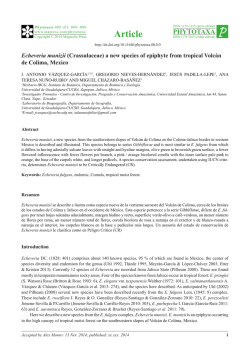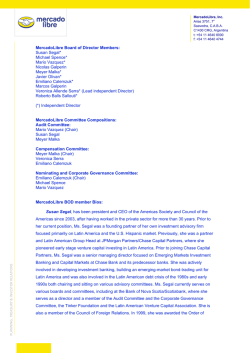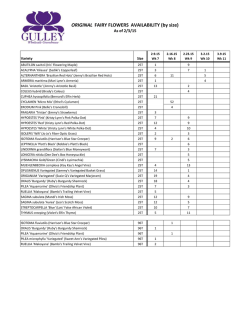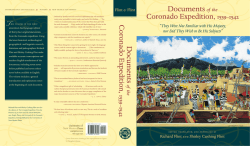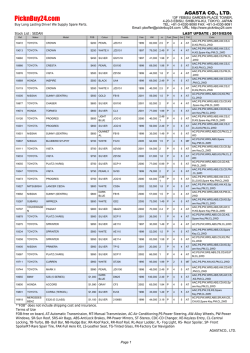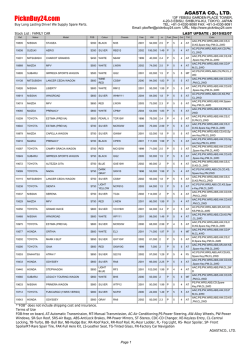
Echeveria cerrograndensis (Crassulaceae) a new species from
Phytotaxa 172 (3): 247–255 www.mapress.com/phytotaxa/ Copyright © 2014 Magnolia Press Article ISSN 1179-3155 (print edition) PHYTOTAXA ISSN 1179-3163 (online edition) http://dx.doi.org/10.11646/phytotaxa.172.3.5 Echeveria cerrograndensis (Crassulaceae) a new species from eastern calcareous Sierra de Manantlán, Colima, Mexico GREGORIO NIEVES-HERNÁNDEZ 1, J. ANTONIO VÁZQUEZ-GARCÍA1, MIGUEL ÁNGEL MUÑIZ-CASTRO1,3, & MIGUEL CHÁZARO-BASÁÑEZ2 Herbario IBUG, Instituto de Botánica, Departamento de Botánica y Zoología, Universidad de Guadalajara-CUCBA, Zapopan, Jalisco, México 2 Laboratorio de Biogeografía, Departamento de Geografía, Universidad de Guadalajara-CUCSH, Guadalajara, Jalisco, México 3 E-mail: [email protected], [email protected] 1 Abstract Echeveria cerrograndensis, a new species from eastern Sierra de Manantlán, in the Jalisco-Colima border, Western Mexico, is described and illustrated. This species belongs to series Gibbiflorae, it is morphologically related to E. fulgens but it differs from the latter in having smaller habit, margin straight to slightly undulate; glaucous to pale green or reddish leaves; lower number of flowers per branch and lower total number of flowers; shorter inflorescences, none bicolored corolla, and dark red thecae and nectaries. A key for the species of the E. fulgens complex is provided. Key words: Echeveria fulgens, endemic, Tolimán, rock flower (“flor de piedra”) Resumen Echeveria cerrograndensis se describe e ilustra como especie nueva de la porción oriental de la Sierra de Manantlán, Jalisco-Colima, México. Esta especie pertenece a la serie Gibbiflorae, se asemeja a E. fulgens, pero difiere de esta última en su hábito más pequeño, hojas glaucas a verde pálido o rojizas con margen recto a ligeramente ondulado, menor número de flores por rama, menor número total de flores, inflorescencias más cortas, corola de un solo color, y en sus tecas y nectarios de color rojo oscuro. Se incluye un clave de identificación para las especies del complejo E. fulgens. Introduction Echeveria DC. (Candolle 1828: 401) comprises some 140 known species, and 95% of these are found in Mexico, the center of diversity and endemism of the genus (Uhl 1992, Thiede 1995, Meyrán-García & López-Chávez 2003, Etter & Kristen 2013). There are nearly 20 species of Echeveria in western Mexico, including the one described here, 15 of which occur in the State of Jalisco, Mexico (Pilbeam 2008), mostly distributed in temperate mountainous rocky areas, with four of them strictly occurring in tropical forests and only two of them inhabiting on calcareous rocks: 1) the ivory-white flowered Echeveria yalmanantlanensis A. Vázquez & Cházaro (Vázquez-García et al. 2013) and 2) the pink flowered Echeveria here described here as new. As expected by Uhl (2002) and Pilbeam (2008), several new species have been described recently out of the Echeveria fulgens Lem. (Lemaire 1845: 8) complex, including E. roseiflora J. Reyes & O. González (Reyes-Santiago & González-Zorzano 2010: 22), E. perezcalixii Jimeno-Sevilla & P.Carrillo (Jimeno-Sevilla & Carrillo-Reyes 2010: 303), and E. purhepecha I. García (García-Ruiz 2011: 63) and E. munizii Padilla Lepe & A.Vázquez (Vázquez-García et al., in press). Here we describe Echeveria cerrograndensis, another new species out of the E. fulgens complex, a rupicolous species in karstic topography of the Cerro Grande massif in the Sierra de Manantlán Biosphere Reserve, Jalisco-Colima, Mexico, a species that despite its abundance remained unnoticed to many botanists undertaking intensive explorations in the natural area (Vázquez et al. 1995). Echeveria cerrograndensis was first discovered in 2002, when Miguel Cházaro, Ignacio Contreras and Antonio Machuca visited Cerro Grande, Minatitlán, Colima, México. Living specimens were obtained on a second trip in July 2004, that later bloomed at home of Antonio Vázquez in January 19, 2005. Accepted by Federico Luebert: 19 Feb. 2014; published: 18 Jun. 2014 247 Taxonomic Treatment Echeveria cerrograndensis A.Vázquez & G. Nieves sp. nov. (Figures 1–4). FIGURE 1. Echeveria cerrograndensis. A. Inflorescence with last fresh flower. B. Inflorescence with developing fruits and shaft leaves. C–D. Flower variability. E–G. Dissected flower showing corolla, one sepal (some sepals missing) pistils, stamens, pedicel, and dark nectaries. H. Panicle. I. Habit J. Habitat and stemmed rosettes. K. Rosette variability. Drawing by Daniel Barba. 248 • Phytotaxa 172 (3) © 2014 Magnolia Press NIEVES-HERNÁNDEZ et al. Type:—MEXICO. Colima: Municipio Minatitlán, Lagunitas-El Terrero, 19°25’8.79’’N, 103°55’7.07’’W, 2200 m, 19 February 2005 (fl, fr), G. Nieves Hernández, Miguel Cházaro, Julia Etter, Raúl López, Ignacio Contreras s.n. (holotype IBUG). Diagnosis:—Echeveria cerrograndensis is morphologically close to E. fulgens in having an evident stem, obovate leaves, erect pedicels and reniform nectaries, but it differs from the latter in having smaller habit, margin straight vs undulate; glaucous to pale green vs yellowish green to dark red; lower number of flowers per branch (1–)3–5(–6) vs 12 or more; smaller total number of flowers (4–11 vs up to 24); inflorescence 10–15 vs up to 90 cm long; corolla none bicolored vs bicolored; thecae and nectaries dark red vs yellow; and base of carpels mostly white vs yellow. FIGURE 2. Echeveria cerrograndensis. Habit variability. Photographs A and B by Gregorio Nieves; C by Rodolfo Sánchez; D by Antonio Vázquez. Echeveria cerrograndensis (Crassulaceae) Phytotaxa 172 (3) © 2014 Magnolia Press • 249 FIGURE 3. Echeveria cerrograndensis. Rosette variability. Photographs A and B by Rodolfo Sánchez; C by Gregorio Nieves; and D by Antonio Vázquez. 250 • Phytotaxa 172 (3) © 2014 Magnolia Press NIEVES-HERNÁNDEZ et al. FIGURE 4. Echeveria cerrograndensis. A–B. Flower variability. C. Dissected flower showing corolla, one sepal, pistils, stamens and dark red nectaries at the base of the ovary. D–F. Panicle variability. Photographs A–D and F by Antonio Vázquez; E by Gregorio Nieves. Echeveria cerrograndensis (Crassulaceae) Phytotaxa 172 (3) © 2014 Magnolia Press • 251 Rupicolous perennial rosette; stem single, erect to decumbent, 2–5 cm long, 1.5 cm diam., pale brown with darker leaf scars (Figure 2). Rosettes 8–11 cm in diam., lax, closed in winter (Figure 3). Leaves (3–)4–6 × 2.5–3.5 cm, basally 1.2–1.5 cm wide, 2 mm thick in the middle, broadly obovate, cuneate at the base, apiculate at the apex, concave, glaucous to pale green, margin straight, entire, pinkish. Floral stem 1–2, erect, 11–22(–35) cm long, including the panicle, 2.5 mm thick in the base, pinkish green; shaft leaves 1.5–3.5 × 0.8–1.3 cm, obovate, pinkish at the margin; panicle, 4–11 flowers, usually two branched, (1–)3–5(–6) flowers per branch (Figures 2 & 4); pedicels straight 8–16 mm long; bracteoles lanceolate, 0.5–1.3 × 0.2–0.5 cm, green to with age; sepals subequal, lanceolate, straight, 0.8 × 0.3 cm; corolla urceolate pentagonal at the base, 1.2 × 1.1 cm; petals 5, 1.2 × 0.5 cm, ovate, concave, acute at the apex, pink throughout, darkened at the tip with age; pinkish white inside; nectaries renniform, dark red 0.2 × 0.1 cm; stamens with white filaments, 5 epipetals 0.9 x 0.1 cm and 5 antisepals, 1 × 0.1 cm; thecae dark red before opening, 0.2 cm long; ginoecium 1.1 × 0.6 cm, white at the base; pistils 1.1 × 0.3 cm, pinkish white at the base and red to dark red toward the apex; stigma black (Figure 4). Distribution, habitat and phenology:—Apparently endemic to the Cerro Grande massif in the eastern Sierra de Manantlán, in Colima state, in Western Mexico (is likely to also be in the Jaliscan part of the Cerro Grande) (Figure 5), growing on karstic topography at 2200 m in elevation, in montane cloud forest including Ferocactus reppenhagenii G.Unger (Unger 1974: 50), Sedum sp., and Salvia vazquezii Iltis & González (Iltis et al. 2012: 343). Flowering from January to February and fruiting from February to March. FIGURE 5. Species distribution of the Echeveria fulgens complex. Echeveria cerrograndensis ( , star), E. fulgens (○, circle), E. roseiflora (+, plus sign), E. perezcalixii ( , gray rhombus), E. purhepecha ( , square), E. munizii ( , triangle), E. sp. ( , black rhombus). Unknown locality of E. fulgens collected in Durango by Palmer [06/635-812 (NY), the same flowered at New York, 09/25951 (US)] (○*, circle and asterisk). Eponimy:—The specific epithet refers to Cerro Grande, the type locality, a 30 km long calcareous massif in the eastern portion of the Sierra de Manantlán, Jalisco-Colima, Mexico. Ethnobotany:— It is occasionally used as ornamental by the local people, and known as “flor de piedra” and “flor de peña” (rock flower); like most succulent species, it has a potential as an ornamental species. 252 • Phytotaxa 172 (3) © 2014 Magnolia Press NIEVES-HERNÁNDEZ et al. Conservation status:—E. cerrograndensis is locally abundant nearby the El Terrero village, but its known extent of occurrence is less than 140 km2. Fortunately, is under protection at the Reserva de la Biosfera Sierra de Manantlán. Additional specimens examined:—MEXICO. Colima: Municipio Minatitlán, Lagunitas-El Terrero, 19°25’47.22’’N, 103°55’18.59’’W, 2200 m, 19 February 2005 (fl, fr) Vázquez et al. s.n. (photographs-IBUG). Minatitlán, Colima, Lagunitas–El Terrero, 19°25’8.79’’N, 103°55’7.07’’W, 2200 m, 24 February 2013 (fl, fr) Cházaro et al. 10600 (IBUG, ENCB, XAL). Discussion:—Echeveria cerrograndensis belongs to series Gibbiflorae (Baker) A.Berger (1930: 474), sensu Moran (1974), a group consisting of medium to large size stemmed plants, lacking pubescence, with a cimose paniculated inflorescence with cincinate lateral branches (Uhl 2002, Kimnach 2003, Meyrán-García & López-Chávez 2003, Carrillo-Reyes et al. 2009). However, E. cerrograndensis is a rather small plant. The caulescent habit with cymosepaniculate inflorescence and lateral cincinate branches suggested a close morphological relationship to Echeveria fulgens, of series Gibbiflorae (Moran 1974), actually a complex that might contain several species (Uhl 2002, Pilbeam 2008). A close examination of the flowers allowed us to conclude that we were dealing with an undescribed taxon here described as a new species. Echeveria cerrograndensis is also morphologically close to E. roseiflora sharing with the latter the non bicolored corolla, red thecae, red nectaries and length of pedicels. However, it differs from the latter in having shorter leaves 3–6 vs. 6–10 cm; broadly obovate vs. oblanceolate-spatulate, leaf margin straight and pinkish vs. crenulated and reddish; shorter inflorescence 11–22(–35) vs. 50–54 cm; smaller total number of flowers 4–11 vs. 18–20; shorter corolla 11–12 vs. 14–16 cm, pedicels straight vs. recurved (Table 1). The following key can be used to determine the species of the Echeveria fulgens complex. TABLE 1. Differences between Echeveria cerrograndensis, E. fulgens and E. roseiflora. Characters E. cerrograndensis E. fulgens E. roseiflora Stem length (cm) 2–5 Up to 30 Not evident Leaves Shape Margin Size (cm) Colour Broadly obovate, apiculate Straight, pinkish(3–)4–6 × 2.5–3.5 Glaucous to pale green Obovate spatulate, rarely apiculate Undulated, reddish 8–15 × 4–7 Green yellowish, somewhat glaucous, to dark red Oblanceolate-spatulate Crenulated, reddish 6–10 × 3.5–5.5 Grayish or olive green to light pink or reddish Inflorescence Size (cm) Flowers per branch Total number of flowers 11–22 (–35) (1–)3–5(–6) 4–11 50–90 12 or more >24 50–54 1–6 18–20 11–12 None bicolored, pink throughout, darkened at the tip with age; pinkish white inside. up to 15 Bicolored, dark pink to red with yellow base, orange inside 14–16 None bicolored, light pink, Thecae colour Dark red Yellow Red Nectaries Dark red Yellow Red Carpel colour Mostly white at the base, red to dark red toward the apex, black at the tips Yellow at the base, red carmine or brown toward the apex Slightly yellow at the base, red to dark red toward the apex 8–16 Straight 2–6 Straight 10–20 Recurved Corolla Length (mm) Colour Pedicels Size of pedicels (mm) Form Echeveria cerrograndensis (Crassulaceae) Phytotaxa 172 (3) © 2014 Magnolia Press • 253 Key to species of the Echeveria fulgens complex 1. - 2. - 3. - 4. - 5. - Nectaries red to dark red.....................................................................................................................................................................2. Nectaries yellow to pale yellow.........................................................................................................................................................3. Stems not evident; leaves 6–10 ×3.5–5.5 cm, margin crenulated and reddish; floral stems 2–3, 50–54 cm, total number of flowers (12–)18–20, nectaries red..................................................................................................................................................E. roseiflora Stems 2–5 cm; leaves (3–)4–6 × 2.5–3.5 cm, margin straight and pinkish; floral stems 1–2, 11–22 (–35) cm, total number of flowers 4–11; nectaries dark red . .......................................................................................................................... E. cerrograndensis Stems 1–11 cm; corolla not bicolored............................................................................................................................................... 4. Stems 15–40 cm; corolla bicolored....................................................................................................................................................5. Stems 1–1.5 cm long, leaves broadly obovate, pale to olive green, grayish green or purple; total number of flowers 7–28; corolla orange pinkish to pink....................................................................................................................................................E. perezcalixii Stems 8–11 cm long, leaves oblong-obovate, pale to dark green; total number of flowers 5–7; corolla scarlet red to coral red......... ....................................................................................................................................................................................... E. purhepecha Bracteoles absent; leaves green yellowish, somewhat glaucous, to dark red, the margin undulated reddish, not hyaline; inflorescence 50–90 cm; total number of flowers ca. 20–24, flowers per branch 12 or more, pedicels 2–6 mm; corolla 12–15 cm long................. .............................................................................................................................................................................................. E. fulgens Bracteoles present; leaves green or olive to brownish green, the margin straight green, hyaline; inflorescence 30–40, total number of flowers 10–11, flowers per branch (1–)3–5, pedicels 7–8 mm; corolla 10–11 cm long................................. E. munizii (in press) Acknowledgements To Daniel Barba, for his excellent art drawings. To Ignacio (Nacho) Contreras, Antonio Machuca, Julia Etter, Raúl López Velázquez and Rodolfo (Roy) Sánchez, field companions and collaborators in trips to Cerro Grande. To Federico Luebert and an anonymous reviewer for their valuable suggestions that improved the manuscript. References Berger, A. (1930) Crassulaceae. In: A. Engler & K. Prantl (eds.), Die natürlichen Pflanzenfamilien 18A (2nd ed.). W.Engelmann, Leipzig, pp. 352–483. Candolle, A.P. (1828) Crassulaceae. In: A. P. de Candolle, A. P. & de Candolle A. L. P. P. (eds.), Prodromus Systematis Naturalis Regni Vegetabilis 3. Treuttel & Würtz, Paris, pp. 382–414. http://dx.doi.org/10.5962/bhl.title.286 Carrillo-Reyes, P., Sosa, V. & Mort, M.E. (2009) Molecular phylogeny of the Acre clade (Crassulaceae): Dealing with the lack of definitions for Echeveria and Sedum. Molecular Phylogenetics and Evolution 53: 267–276. http://dx.doi.org/10.1016/j.ympev.2009.05.022 Etter, J. & Kristen, M. (2013) Crassulaceae. Data base. Available from: http://www.crassulaceae.com/botanik/botcrassulaceae_en.asp (accessed: 05 February 2013). García-Ruiz, I. (2011) Nueva especie de Echeveria del centro-occidente de Michoacán, México. Revista Mexicana de Biodiversidad 82: 63–67. Iltis, H.H., González-Gallegos, J.G., Cochrane, T.S., & Vázquez-García, J.A. (2012) A new species and a new subspecies of Salvia (Lamiaceae) from Jalisco and Michoacán, Mexico. Brittonia 64: 343–352. http://dx.doi.org/10.1007/s12228-012-9237-1 Jimeno-Sevilla, H.D. & Carrillo-Reyes, P. (2010) Echeveria perezcalixii, una especie nueva del occidente de México. Brittonia 62: 303– 308. http://dx.doi.org/10.1007/s12228-010-9137-1 Kimnach, M. (2003) Echeveria. In: Eggli, U. (ed.), Illustrated Handbook of Succulent Plants: Crassulaceae. Springer, Berlin, pp.103– 128. Lemaire, A.C. (1845) Echeveria fulgens: Crassulacées & Obilicees. Hortus Vanhoutteanus 1: 8. Meyrán-García, J. & López-Chávez, L. (2003) Las Crasuláceas de México. Sociedad Mexicana de Cactología, A.C. México, D.F., 234 pp. Moran, R. (1974) Division of genus Echeveria into series. In: Jacobsen, H. (ed.), Lexicon on succulent plants. Blandford Prees, London, pp. 184–186. Pilbeam, J. (2008) The genus Echeveria. The British Cactus & Succulent Society, Essex, 333 pp. 254 • Phytotaxa 172 (3) © 2014 Magnolia Press NIEVES-HERNÁNDEZ et al. Reyes-Santiago, J. & González-Zorzano, O. (2010) Echeveria roseiflora (Crassulaceae) una nueva especie para el estado de Jalisco, México. Cactáceas y Suculentas Mexicanas. 55: 19–26. Thiede, J. (1995) Quantitative phytogeography, species richness, and evolution of American Crassulaceae. In: Hart, H. & Eggli, U. (eds.), Evolution and systematics of the Crassulaceae. Backhuys Publishers, Leiden, pp. 89–123. Uhl, C.H. (1992) Polyploidy, dysploidy and chromsome pairing in Echeveria (Crassulaceae) and its hybrids. American Journal of Botany 79: 556–566. http://dx.doi.org/10.2307/2444868 Uhl, C.H. (2002) Chromosomes and hybrids of Echeveria (Crassulaceae). VII. Series Gibbiflorae (Baker) Berger. Haseltonia 9: 121– 145. http://dx.doi.org/10.2985/1070-0048(2005)11[138:cahoed]2.0.co;2 Unger G. (1974) Ferocactus reppenhagenii Unger spec. nov. Kakteen und Andere Sukkulenten 25: 50–54. Vázquez-García, J.A., Cuevas-G., R., Cochrane, T. S., Iltis, H.H., Santana-M., F.J. & Guzmán-H., L. (1995) Flora de Manantlán. Sida Botanical Miscellany 13: 1–312. Vázquez-García, J.A., Jimeno-S., D., Cuevas-Guzmán, R., Cházaro-B., M. & Muñiz-Castro, M.A. (2013) Echeveria yalmanantlanensis (Crassulaceae) a new species from Cerro Grande, Sierra de Manantlán, western Mexico. Brittonia 65: 273–279. http://dx.doi.org/10.1007/s12228-012-9274-9 Vázquez-García, J.A. Nieves-Hernández, G., Padilla-Lepe, J., Nuño-Rubio, A.T. & Cházaro-Basáñez, M. (2014, in press). Echeveria munizii (Crassulaceae) an epiphytic new species in tropical gallery forest at Volcán de Colima, Mexico. Phytotaxa. Echeveria cerrograndensis (Crassulaceae) Phytotaxa 172 (3) © 2014 Magnolia Press • 255
© Copyright 2025
